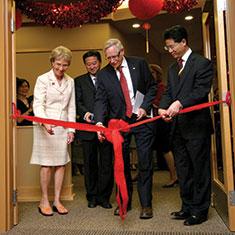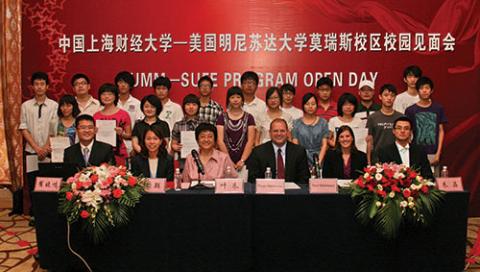The University of Minnesota has had countless successful collaborations and strategic partnerships with Chinese universities over the past 100 years. The rich history between the University and China has paved the way for continued collaborations and partnerships, which are anticipated to flourish in the years to come thanks to several newly signed agreements.
University-China Joint Programs

Several University units have joint programs with partners in China. A few highlights include the Carlson School of Management’s China Executive Master of Business Administration (CHEMBA) program. With official approval from the Chinese Ministry of Education and the Academic Degrees Committee of the State Council in 1999, the program is housed in Guangzhou in collaboration with Sun Yat-Sen University Lingnan College. It is ranked as a top EMBA program in southern China and has trained over 400 alumni since 2001.
The University collaborated with Hanban/Confucius Institute Headquarters and Capital Normal University in Beijing to establish the Confucius Institute at the University of Minnesota (CIUMN) in 2008. Until 2019, the mission of CIUMN was to promote the study of Chinese language and culture throughout Minnesota. It had offices on the University of Minnesota’s Crookston, Duluth, and Twin Cities campuses.
In 2009, the University of Minnesota Morris signed a partnership agreement with Shanghai University of Finance and Economics. The partnership offers qualified Chinese students the opportunity to complete their first year of baccalaureate study in Shanghai and then transfer to the Morris campus. Students then earn a bachelor’s degree from the University of Minnesota.

Sharing Specialties and Strengths
University departments and faculty generously share their expertise and welcome the knowledge of Chinese peers. These friendships have spurred wonderful collaborations including the recent partnership between the University of Minnesota Crookston and Zhejiang Economic and Trade Polytechnic to establish an American Cultural Center for Culture Exchange in Hangzhou, China. The center opened in 2012 and offers several learning resources, including a 3D lab that allow users to “immerse” themselves in a virtual environment and interact with that environment.
The University’s School of Dentistry welcomed a delegation from Sun Yat-Sen University’s Guanghua School of Stomatology in 2013, where the two parties agreed on future collaboration in the areas of oral and maxillofacial surgery and prosthodontics. Guanghua School of Stomatology has hosted exchange faculty from the University of Minnesota in the past.
Since 2010, the University’s School of Nursing has worked with Taiwan’s National Yang Ming University School of Nursing on various projects. The partnership will continue for years to come as a collaborative agreement was renewed in 2013. The focus of the collaboration is on informatics and nursing, which is one of the University of Minnesota’s nationally ranked strengths.
Global Scientists

Many University departments and faculty members expand and share their knowledge by participating in and organizing international networking opportunities. The University’s College of Science and Engineering collaborated with the Chinese Academy of Sciences on academic seminars, which provided a bilateral channel for faculty and students to discuss technological research. It was hosted in Beijing in 2005 and again in 2007 in Minneapolis. Today, Professor David Pui travels extensively, including to China, to address the PM 2.5 air pollutant challenge and collaborates with Chinese scientists on technological solutions.
In 2012, the University’s College of Veterinary Medicine organized the first annual Leman Swine Conference in Xi’an, China. The conference focused on the latest developments on swine research and production, disease surveillance and control, integration of production and public health, and their impacts on the global economy and China–the world’s biggest pork-producing country. The conference attracted professionals from China and North America.
This information was compiled in 2014 for China 100, a yearlong celebration honoring the first students from China and the wealth of connections that have come since.
